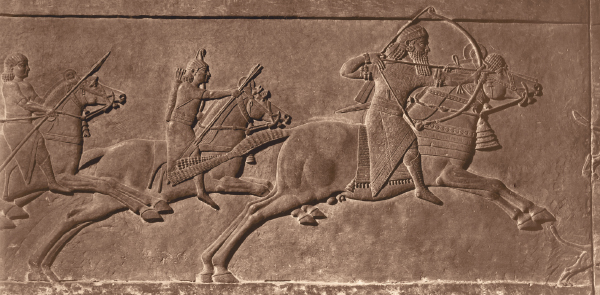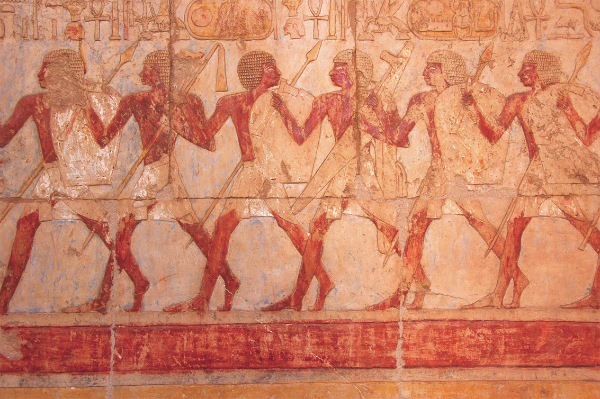Messages about Egypt (46:1–28)
Concerning the nations (46:1). This chapter begins a section in Jeremiah defined as the “Oracles against the Foreign Nations” (Jer. 46–51). This is a distinct literary genre within the prophets (see sidebar on “Oracles against the Nations”).
Against the army of Pharaoh Necho (46:2). Pharaoh Necho II was part of the Twenty-Sixth Dynasty (Saite) in Egypt (664–525 B.C.); he ruled from 610–595 B.C. At the beginning of his rule much was changing in Mesopotamia. The powerful Assyrian empire had suffered two deadly blows. Nineveh was defeated by the Babylonians and Medes in 612 B.C., and two years later the Assyrians suffered another defeat at Haran. In light of this, Necho II decided to venture north through Palestine in order to provide help to the Assyrians. On the way he killed Josiah king of Judah at the Battle of Megiddo in 609 B.C. This turned out to be a devastating blow to the inhabitants of Judah.
Necho II then attempted to aid the Assyrians by establishing himself at Carchemish. However, in 605 B.C., during the famous Battle of Carchemish, the Babylonian army defeated the Egyptians, sending them back to Egypt. Shortly thereafter, the Babylonians continued to conquer southward until they had control over all Palestine right to the border of Egypt.342
Shields, both large and small (46:3). Most ancient Near Eastern soldiers were armed with shields for protection. At least two types of shields were used by Israelite warriors. The small one was round and rather light. It served as a buckler, was generally held in the left hand, and was often used to protect the face. This type of shield can be seen in the Lachish relief343 and is frequently mentioned in the Hebrew Bible. Egyptian soldiers also used a small shield. These were rounded at the top and rectangular at the bottom.344 Unfortunately, most shields in the ancient Near East were made of perishable materials such as wood covered with skin or wickerwork and leather.345

Assyrian relief of the capture of an Egyptian fortress depicts a variety of shields.
Todd Bolen/www.BiblePlaces.com
The larger shield could be of different shapes: rectangular, oblong, or figure eight. These protected the entire body, particularly from spears, lances, and arrows. They were used often in siege warfare to protect the archers. It was a heavier shield that did not allow for quick maneuverability. This meant that some foot soldiers were aided by a shield bearer, who stood by his side. There are a number of reliefs that show King Ashurbanipal of Assyria (669–633 B.C.) at war in which one can see these larger shields, both oblong and rectangular.346
Harness the horses, mount the steeds (46:4). There is no conclusive evidence that the Egyptian army used cavalry at this time (seventh century B.C.). But Assyrian and Babylonian armies had been using chariots and cavalry already in the tenth century B.C. There are numerous reliefs from the time of King Ashur-nasir-apal II (884–858 B.C.) on that depict Assyrian armies with both chariots and cavalry.347 By the time of Tiglath-pileser III (745–727 B.C.), cavalry became much more important in Mesopotamian armies.348 Sometime later, during the reign of Ashurbanipal (669–663 B.C.), horses were also used for hunting lions and onagers.349 The intensive use of cavalry may have given the Assyrians and Babylonians a decided military advantage over the Egyptians. In fact, there may be a hint of irony in Jeremiah’s command to mount the steeds.

Relief from Palace of Ashurbanipal shows mounted warriors, though here they are engaged in lion hunt.
Werner Forman Archive/British Museum, London
Take your positions with helmets on (46:4). Helmets in the ancient Near East were usually made of leather or metal and were used as defensive headgear.350 In fact, the mighty Philistine warrior Goliath wore a bronze helmet (1 Sam. 17:5, 38). The helmets had different shapes: round, cone-shaped, and with flaps to cover the cheek and ears. Reliefs from Assyria show their warriors wearing cone-shaped helmets.351

Helmets on Assyrian soldiers
Francesca Smith-Archiapatti, courtesy of the British Museum
Cush (46:9). Cush is the biblical name for Ethiopia—an area south of Egypt that corresponds to modern-day Sudan and perhaps includes Ethiopia as well. It was inhabited by non-Egyptians. It was also identified from early times as Nubia.352 Cush along with Put and Lydia represent mercenary contingents who participated in the Egyptian army and thus served as reminders of past political and military events in Egypt’s history.

Cushite warriors
Frederick J. Mabie
A Nubian named Shabako founded the Nubian (Cushite) dynasty (eighth to seventh centuries B.C.), also known as the Twenty-Fifth Dynasty in Egypt. The third king of that dynasty (Tirhakah) sent an army to aid Hezekiah in his struggle against Sennacherib king of Assyria (704–681 B.C.). This surge in power is perhaps the reason why Cush receives a prominent place in this message for Egypt.
Put (46:9). Put is synonymous with Libya. This identification is based on the translation of Put in the LXX and in the Vulgate, as well as Old Persian inscriptions.353 The geographical location of Put cannot be known with precision. Probably it was located to the west of Egypt. Put as well as Cush are listed in the Table of Nations in Genesis 10 as sons of Ham and brothers of Egypt (Gen. 10:6).
Lydia (46:9). Lydia can be identified with the Ludites of Genesis 10:13. We suggest that Lydia here refers to the Lydia in Asia Minor. History tells us that Psammetichus of the Egyptian Saite Dynasty received help from Gyges, king of Lydia, to resist the Assyrian army during the first half of the seventh century.354 Since then, Lydian mercenaries were present in Egypt.355
Go up to Gilead and get balm (46:11). See comments on 8:22.
O Virgin Daughter of Egypt (46:11). This may be an ironic use of the title. Jeremiah had used a similar title for Israel (see comments on 18:13).
Nebuchadnezzar king of Babylon to attack Egypt (46:13). See comments on 43:11.
Migdol … Memphis … Tahpanhes (46:14). See comments on 2:16; 43:7, 9; 44:1.
Tabor (46:18). This important mountain is located in the northeast corner of the Jezreel Valley, which is the southern limit of lower Galilee. It lies about six miles east of Nazareth and reaches about 1,800 feet in altitude. Its inverted bowl-like shape attracted attention in ancient times.356 Mount Tabor’s importance lay mainly in its location. Placed on the edge of the Jezreel Valley, it was a constant witness to commercial and military movements that went north–south. When the Egyptians fled south after being defeated by the Babylonians, they most likely passed through the Jezreel Valley and therefore were in full view of Mount Tabor.

View of Jezreel Valley from Mount Carmel
Todd Bolen/www.BiblePlaces.com
Carmel (46:18). Mount Carmel is located on the Mediterranean Sea just to the west of the present port of Haifa and rises to about 1,620 feet. Once again its location is important. It has a view of the Mediterranean but also a view of the Jezreel Valley as it is located on the southwest border of that strategic valley. The Carmel range is covered with rich soil and extends southeast for about thirteen miles. Nebuchadnezzar, the king of Babylon who will invade Egypt, is compared to these two important and strategic mountains.
For Memphis will be laid waste (46:19). See comments on 2:16.
A gadlfy is coming (46:20). The Hebrew term used here (qereṣ) occurs only here in the Hebrew Bible. It is generally understood to designate a horsefly or gadfly (Tabanus bovinus). A Ugaritic cognate verb means “to gnaw, bite, rip off.” Thus, this insect seems to be one that stings cattle, since Egypt is described as a heifer in the previous line. Babylon is compared to a gadfly that will come from the north to bite, sting, and inflict injury on Egypt.
Like a fleeing serpent (46:22). Though the Hebrew text here is not altogether clear, we can suggest a meaning from the context. The entire poem speaks of danger and destruction that awaits Egypt. The serpent is an important symbol in Egypt, and no doubt here the nation is compared to a serpent that is being attacked. Fear runs throughout the leadership and people of Egypt as the northern foe closes in on them.
Like men who cut down trees (46:22). The image conveyed here is one of destruction. The enemy from the north comes with axes not only to destroy a forest but also to destroy the nation.357 Assyrian bas reliefs show chariots that carried up to four soldiers armed with bows, arrows, and sometimes axes.
The evidence suggests that particularly Neo-Assyrian kings customarily destroyed the orchards of their enemies. This seems to have been part of their military strategy.358 One must admit, however, that Egypt is not known for its forests.
Amon god of Thebes (46:25). Thebes is the Greek name that refers to a city the Egyptians called Waset. It was the most important city in Egypt after Memphis and was located on the Nile River 438 miles south of the Mediterranean and 140 miles north of Elephantine (see comments on 43:7). It served as the capital city of Egypt from the Middle Kingdom (ca. 2100 B.C.) up until the Assyrian invasion led by Ashurbanipal (ca. 663/661 B.C.). In Egyptian texts Thebes is referred to as “the city of Amon.”359

Amun-Re
Manfred Näder, Gabana Studios, Germany
This is evidence that in the early stages, the most important god of Thebes, and by extension of Egypt, was Amon. This god was known as the “Hidden One.” He was manifested in the wind, whose origin and destination cannot be known. Amon was also the mysterious source of life in human beings and animals. As time progressed and as the Egyptians acknowledged more and more the power in the sun, a fusion took place between the sun god Re and the god of life and breath, Amon. It was conveniently argued that they were one and the same;360 the result was the god Amon-Re. The famous temple of Karnak at Thebes was dedicated to Amon-Re, who became the head of the Egyptian pantheon at the beginning of the New Kingdom (ca. 1550 B.C.).
